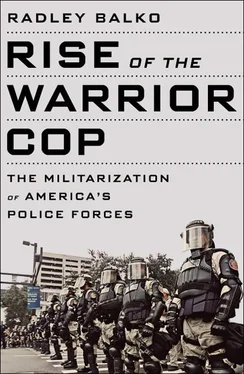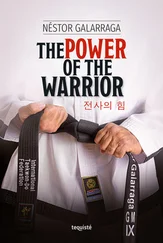Nixon looked at “his people” and found them quaking with rage and fear: not at Vietnam, but at the… unholy amalgam of stoned hippies, braless women, homicidal Negroes, larcenous junkies, and treasonous priests. Nixon’s genius was in hammering these images together into a rhetorical sword. People steal, burn, and use drugs not because of “root causes”… but because they are bad people. They should be punished, not coddled….
Another poll taken just weeks before the election showed the power of television: while a majority of Americans feared the country was headed toward “anarchy,” just 28 percent felt that crime had gone up in their own communities. 64Most Americans felt perfectly safe walking in their own neighborhoods, but assumed most of their fellow citizens didn’t feel the same way. As he slogged through the primaries in early 1968, Nixon was well aware of this. People don’t have to experience crime firsthand to feel threatened by it, he wrote to his old friend and mentor, Dwight Eisenhower. “I have found great audience response to this [law-and-order] theme in all parts of the country, including areas like New Hampshire where there is virtually no race problem and relatively little crime.” 65
Shortly before the 1968 election, Nixon called illicit drugs “the modern curse of the youth, just like the plagues and epidemics of former years. And they are decimating a generation of Americans.” 66He wouldn’t explicitly “declare war” on drugs for another few years. But his rhetoric was already slipping into combat fatigues.
THE LAW-AND-ORDER CAMPAIGN WORKED. NIXON WON THE 1968 election by a comfortable margin in the electoral college. (And when you factor in the votes for George Wallace, Humphrey lost the popular vote by a wide margin.) The Republicans also picked up five seats in the Senate and five in the House. In four years, crime had become the most important issue in the country.
The new administration wasted little time. The White House point man on crime would be Egil Krogh, a twenty-nine-year-old family friend of Nixon aide John Ehrlichman. Though just out of law school, Krogh would make crime policy for the entire country. In December 1968—before Nixon had yet been inaugurated—Krogh and Ehrlichman had a strategy session with Nebraska senator Roman Hruska, the ranking minority member on the Judiciary Committee. Hruska had an idea to assemble a crime bill just for the District of Columbia. Congress had jurisdiction over the city, making it an ideal spot to test out new ideas without worrying about encroaching on the traditional federalist approach to crime. DC at the time wasn’t any more dangerous than other large cities. But less than a year had gone by since the riots after the death of Martin Luther King, and there was at least the perception that the city was uniquely dangerous, especially for muggings and robberies. At the top of Hruska’s wish list for DC were the preventive detention and no-knock raid provisions that had been cut out of the crime bill passed six months earlier. 67
Krogh took Hruska’s idea to John Mitchell, Nixon’s nominee for attorney general. Mitchell had run Nixon’s law-and-order-themed campaign, so it was natural for the president-elect to select his good friend to run the Justice Department. A former semipro hockey player, Mitchell had commanded a PT boat during World War II. (Coincidentally, his lieutenant was John F. Kennedy.) After the war he became a successful, self-made municipal bond lawyer. Mitchell was exposed to the power of law-and-order issues while serving as a bond counsel for the Rockefeller administration in New York. He and Nixon became friends when their law firms merged in 1967. John Mitchell would be the public face of Nixon’s crime policy. 68
The new administration held two big strategy sessions on crime, one just before Nixon took office and another shortly after his inauguration. Also attending these meetings, in addition to Krogh, were Santarelli (soon to be an aide to Mitchell), GOP chief house counsel John Dean, Ehrlichman, and future senator Daniel Patrick Moynihan, then a domestic policy adviser. Nixon himself sat in on the initial meeting. 69The first order of business was to figure out which crimes to target. Mitchell made clear in both meetings that the crimes that seemed to most worry the public—armed robbery and burglary—weren’t the purview of the federal government. Moreover, there was no political benefit to tackling those crimes. Even if the administration’s policies worked, local law enforcement would get most of the credit. 70
They decided that the high-profile target of the new administration’s promised anticrime effort would be drug control. Drug use, they thought, was the common denominator among the groups—low-income blacks, the counterculture, and the antiwar movement—against whom Nixon had unified “ignored America.” Because the drug trade crossed both state and international borders, there were also no federalism issues. So it was decided that the new Nixon administration would push for massive budget increases for agencies like BNDD and LEAA. They would ask for a thousand new police officers for DC—an idea that, oddly enough, came from Washington Post publisher Katharine Graham in a personal plea to Ehrlichman. And of course, they’d demand no-knock and preventive detention for federal drug agents, just as they would for police in Washington, DC. 71
The Nixonites mulled a number of other constitutionally dubious drug war proposals in addition to the preventive detention and no-knock proposals. They wanted to authorize the use of “loose search warrants.” These would have allowed police to apply for a warrant for contraband, then search multiple properties to find it. The idea came precipitously close to a writ of assistance, but without the restrictions on nighttime service and knock-and-announce. Combined with the no-knock provision, it would have essentially authorized police to kick down the doors of entire neighborhoods with a single warrant. 72Loose warrants didn’t make the final crime bill, but the idea was really only about ten years ahead of its time. Starting in the 1980s, police would conduct raids of entire city blocks, housing complexes, and neighborhoods. The Nixon administration also wanted to strip away attorney-client privilege, as well as the privilege afforded to conversations with priests and doctors, and to expand wiretapping authority. They even came up with an early precursor to California’s eventual “three strikes and you’re out” law. 73
No one had any idea if these policies would work, but in a way it didn’t matter. The strategy was as much about symbolism and making the right enemies as it was about effectiveness. 74There was much discussion over whether the policies sounded harsh enough or sounded too harsh. There was at least some discussion over whether they would actually work. But there was very little internal discussion about whether the policies were constitutional, whether they were susceptible to abuse, whether they would have unintended consequences, or what impact they might have on the communities they’d be enforced against.
On July 14, 1969, Nixon gave his first major address to Congress to outline his antidrug program. He declared drugs a “national threat.” He set the tone for a much more aggressive, confrontational federal drug fight. He described the “inhumanity” of drug pushers, laying groundwork for the sort of dehumanizing rhetoric that would be used for years to come to reduce drug users and drug dealers to an enemy to be destroyed. “Society has few judgments too severe, few penalties too harsh for the men who make their livelihood in the narcotics traffic,” he said. To that end, he proposed massive budget increases for BNDD and asked for money to hire scores of new federal narcotics officers. He called for the creation of “special forces” within the agency that “will have the capacity to reave quickly into any area in which intelligence indicates major criminal enterprises are engaged in the narcotics traffic.” Borrowing more military terminology, he asked that Congress make funding for the units available soon so that they could “fully deploy” by 1971. 75
Читать дальше













